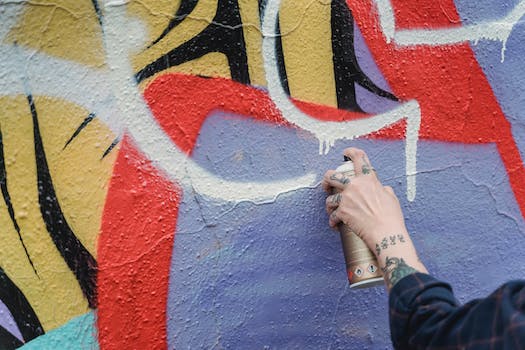Transforming Walls with Ombre Effect is a captivating way to add depth, style, and visual interest to any space. Ombre, derived from the French word meaning ‘shaded,’ is a technique that involves blending colors from light to dark or vice versa. By incorporating this artistic gradient effect on your walls, you can effortlessly create a stunning and unique focal point that will leave a lasting impression. Whether you prefer a subtle and soothing transition or a bold and dramatic statement, the possibilities with ombre are endless. In this article, we will explore various methods, tips, and ideas to help you achieve the perfect ombre effect for your walls and transform your living spaces into works of art.
- 1. Introduction
- 1.1. What is the ombre effect?
- 1.2. History of the ombre effect
- 1.3. Popularity of the ombre effect in interior design
- 1.4. Benefits of using the ombre effect on walls
- 1.5. How to choose the right colors for the ombre effect
- 2. Preparing the Wall
- 2.1. Cleaning the wall surface
- 2.2. Repairing any damages
- 2.3. Applying primer
- 2.4. Taping off areas
- 2.5. Creating a smooth base
- 3. Applying the Ombre Effect
- 3.1. Choosing the base color
- 3.2. Mixing the gradient colors
- 3.3. Starting from the bottom
- 3.4. Blending the colors
- 3.5. Adding additional layers
1. Introduction
The ombre effect is a popular trend in interior design that adds depth and dimension to any space. By gradually blending one color into another, this technique creates a stunning visual effect that can transform plain walls into works of art. Whether you want to create a subtle gradient or a bold statement, the ombre effect offers endless possibilities for enhancing the aesthetic appeal of your home. In this article, we will explore various ways to achieve the ombre effect on walls, from simple painting techniques to more advanced DIY projects. So let’s dive in and discover how to bring this captivating ombre effect into your living space.
1.1. What is the ombre effect?
The ombre effect is a popular technique used to create a gradient or fading effect on walls, furniture, and other surfaces. Inspired by the French word meaning ‘shaded’ or ‘shadow’, ombre involves blending two or more colors seamlessly, creating a stunning visual transition from light to dark or vice versa.
This artistic technique has gained immense popularity in interior design, allowing homeowners to add depth, dimension, and a touch of elegance to their living spaces. With the ombre effect, walls can be transformed into captivating focal points, creating a unique and personalized look.
Whether you prefer a subtle and understated gradient or a bold and vibrant color transition, the ombre effect offers endless possibilities for creative expression. From soft pastels to rich jewel tones, the choice of colors is entirely up to your personal style and the ambiance you wish to create in your space.
In this article, we will explore the different ways you can incorporate the ombre effect into your home, the various techniques involved, and how to achieve a flawless finish. Get ready to discover the transformative power of the ombre effect and bring a touch of artistic flair to your walls!
1.2. History of the ombre effect
The ombre effect is a popular technique that has been used for centuries to add depth and dimension to various forms of art. Its origins can be traced back to the French word ‘ombre,’ meaning ‘shaded’ or ‘shadow.’ The technique involves blending colors or tones seamlessly from light to dark, creating a gradient effect that transitions smoothly. This artistic style has been widely utilized in painting, textile design, and even hair coloring. In recent years, the ombre effect has gained significant popularity in interior design, particularly for transforming walls into stunning focal points. Let’s explore the history of the ombre effect and its evolution as a trend in home decor.
1.3. Popularity of the ombre effect in interior design
The ombre effect has gained immense popularity in the world of interior design. This unique technique involves blending two or more colors seamlessly, creating a gradient effect that adds depth and visual interest to any space. From walls to furniture, the ombre effect has become a go-to choice for homeowners and designers alike.
With its origins in the world of fashion and hair styling, the ombre trend has successfully made its way into interior design. The versatility of this technique allows for endless possibilities, as it can be applied to various surfaces and materials. Whether it’s a subtle transition from light to dark or a bold mix of vibrant hues, the ombre effect has the power to transform walls and elevate the overall aesthetic of a room.
One of the reasons behind the popularity of the ombre effect is its ability to create a sense of movement and dimension. By seamlessly blending different shades, the ombre effect adds depth and visual texture to a space, making it appear more dynamic and lively.
Additionally, the ombre effect offers a wide range of color options, allowing individuals to choose a palette that suits their personal style and preferences. Whether you prefer a monochromatic look or want to experiment with contrasting colors, the ombre effect can be customized to fit any design concept.
Furthermore, the ombre effect is a relatively simple and cost-effective way to update the look of a room. It can be achieved through various techniques such as painting, wallpapering, or using gradient textiles. This versatility makes it accessible to homeowners who are looking for a quick and affordable way to refresh their living spaces.
In conclusion, the popularity of the ombre effect in interior design can be attributed to its ability to add visual interest, create movement, offer a wide range of color options, and provide a cost-effective solution for transforming walls. Whether you want to create a subtle or dramatic effect, the ombre trend is here to stay, revolutionizing the way we perceive and decorate our living spaces.
1.4. Benefits of using the ombre effect on walls
The ombre effect is a popular and visually stunning technique that can be used to transform the walls of any space. This technique involves blending two or more colors together to create a gradient effect, where one color smoothly transitions into another. The result is a beautiful and unique look that adds depth and dimension to a room.
There are numerous benefits to using the ombre effect on walls. Firstly, it allows you to create a focal point in a space and draw attention to a specific area. By using bold and contrasting colors, you can make a statement and add visual interest to an otherwise plain wall.
Additionally, the ombre effect can help to create the illusion of a larger space. By using lighter colors at the top and gradually transitioning to darker shades at the bottom, you can make a room appear taller or wider. This is especially beneficial for small or cramped rooms that may lack natural light.
Furthermore, the ombre effect is a versatile technique that can be used in various design styles. Whether your space is modern, bohemian, or traditional, the ombre effect can be tailored to suit your aesthetic preferences. You can choose to use soft and subtle colors for a more serene and calming atmosphere, or opt for vibrant and bold shades to make a bold statement.
In conclusion, using the ombre effect on walls can transform a space and elevate its visual appeal. From creating a focal point to making a room appear larger, this technique offers numerous benefits. So, whether you’re looking to update your living room, bedroom, or office, consider incorporating the ombre effect to add a touch of style and sophistication.
1.5. How to choose the right colors for the ombre effect
The ombre effect is a popular technique for transforming walls and adding a touch of creativity to any space. By blending two or more colors together, this technique creates a stunning gradient effect that can bring life and depth to a room. However, choosing the right colors for the ombre effect can be a daunting task. In this section, we will explore some tips on how to select the perfect colors for your ombre wall.
2. Preparing the Wall
Preparing the wall is an essential step when transforming walls with the ombre effect. This technique involves creating a gradient of colors that fade into each other, giving a beautiful and unique look to any room. To achieve the best results, it is important to properly prepare the wall before starting the ombre painting process.
Firstly, make sure the wall is clean and free from any dirt, dust, or grease. Use a mild detergent and water solution to gently wash the surface, and then allow it to dry completely. This will ensure a smooth and even base for the ombre painting.
Next, inspect the wall for any imperfections, such as cracks, holes, or uneven surfaces. Fill in any cracks or holes with a suitable filler and sand down any rough areas to create a seamless finish. It is crucial to have a smooth surface to achieve a professional ombre effect.
Afterward, apply a primer to the entire wall. The primer will help to seal the surface and provide a better adhesion for the paint. Choose a primer that is specifically designed for the type of wall you have, whether it is drywall, plaster, or any other material.
Once the primer is dry, you can start applying the base color for the ombre effect. Select the colors you want to use for the gradient and mix them accordingly. Begin painting from the bottom of the wall, gradually blending the colors as you move upward. It is important to work quickly and blend the colors while they are still wet to achieve a seamless transition.
Lastly, allow the base color to dry completely before proceeding with the ombre technique. This will ensure that the colors do not mix or smudge during the process. Once the base color is dry, you can begin creating the ombre effect by layering lighter shades of the base color on top, gradually fading them out as you move upward.
In conclusion, preparing the wall is a crucial step in transforming walls with the ombre effect. By following these steps and ensuring a clean, smooth, and primed surface, you will be able to achieve a stunning ombre look that will enhance the beauty of any space.
2.1. Cleaning the wall surface
Cleaning the wall surface is an essential step in preparing the wall for transforming with the ombre effect. Before applying any paint or technique, it is important to ensure that the surface is clean and free from dirt, dust, and grease. This will help the paint adhere better and result in a smooth and professional-looking finish.
To clean the wall surface, start by removing any loose dirt or cobwebs using a broom or vacuum cleaner with a brush attachment. Pay attention to corners and crevices where dust tends to accumulate.
Next, mix a mild detergent or dish soap with warm water in a bucket. Dip a sponge or soft cloth into the soapy water and gently scrub the wall surface in a circular motion. Be careful not to apply too much pressure or use abrasive materials that could damage the paint or wall.
After cleaning the entire wall surface, rinse it thoroughly with clean water using a separate sponge or cloth. This will remove any residue from the soap or cleaner.
Allow the wall to dry completely before proceeding with the ombre effect. You can use a clean, dry cloth or allow it to air dry naturally.
Cleaning the wall surface ensures a clean canvas for the ombre effect and helps the paint adhere properly, resulting in a stunning transformation of the walls.
2.2. Repairing any damages
Repairing any damages
Before you can start transforming your walls with the ombre effect, it’s important to ensure that the surface is in good condition. Begin by inspecting the wall for any damages such as cracks, holes, or peeling paint. If you come across any of these issues, it’s vital to repair them before proceeding.
To repair small cracks or holes, start by cleaning the area around the damaged spot. Use a scraper or sandpaper to gently remove any loose or flaking paint. Next, fill the crack or hole with a patching compound using a putty knife. Smooth out the surface and let it dry according to the manufacturer’s instructions. Once dry, sand the patched area until it’s level with the rest of the wall.
For larger damages, such as extensive cracking or water damage, it may be necessary to consult a professional to ensure proper repair. They can assess the situation and provide the best solution for restoring the wall’s integrity.
By addressing any damages beforehand, you can create a smooth and even surface for applying the ombre effect, ensuring that it will have a stunning and flawless finish.
2.3. Applying primer
Before applying the primer, it is important to properly prepare the wall to ensure the best results for transforming walls with the Ombre effect. Here are the steps to follow:
1. Clean the wall: Start by cleaning the wall thoroughly to remove any dirt, dust, or grease. Use a mild detergent and warm water solution to scrub the surface gently. Rinse the wall with clean water and allow it to dry completely.
2. Repair any damages: Inspect the wall for any cracks, holes, or imperfections. Fill these areas with a suitable wall filler or spackle, and smooth it out with a putty knife. Once the filler is dry, sand it lightly to achieve a smooth surface.
3. Sand the wall: If the wall has a glossy or uneven finish, it is essential to sand it lightly. This will help the primer adhere better to the surface. Use a fine-grit sandpaper and sand the entire wall in a circular motion. Wipe away the dust with a clean cloth.
4. Protect adjacent surfaces: Before applying the primer, make sure to protect any adjacent surfaces such as floors, baseboards, or furniture. Cover them with plastic sheets or painter’s tape to prevent any accidental paint splatters.
Once the wall is properly prepared, it is ready for the application of primer, which will create a smooth and even base for the Ombre effect.
2.4. Taping off areas
Taping off areas is an essential step in preparing the wall for transforming it with the ombre effect. This technique involves creating a gradient effect from one color to another, giving the wall a visually stunning appearance.
Before starting the taping process, it is important to gather all the necessary materials. This includes painter’s tape, a measuring tape, a pencil, and a level. These tools will help ensure accurate and straight lines.
Begin by determining the desired height and width of the ombre effect. Use the measuring tape to mark the specific measurements on the wall with a pencil. This will serve as a guide for taping off the areas.
Next, take the painter’s tape and carefully apply it along the pencil marks. Make sure to press the tape firmly against the wall to prevent any bleeding of paint.
Once the tape is in place, use a level to ensure that the lines are straight and even. Adjust the tape if needed to achieve the desired effect.
After completing the taping process, the wall is now ready for the next step: applying the ombre paint colors. The taped-off areas will act as boundaries, allowing for a clean and seamless transition of colors.
Taping off areas is a crucial part of the preparation process as it helps create sharp and defined lines. It ensures that the ombre effect is executed flawlessly, resulting in a visually striking transformation of the walls.
2.5. Creating a smooth base
Before you can start transforming your walls with the stunning ombre effect, it’s essential to prepare the surface properly. Creating a smooth base will ensure that the final result is flawless and long-lasting.
To begin, remove any existing wallpaper or loose paint from the wall. Use a scraper or sandpaper to gently get rid of any imperfections or roughness. Make sure to clean the wall thoroughly afterward to remove any dust or debris.
Next, fill in any holes or cracks using a suitable filler. Apply the filler with a putty knife and smooth it out evenly. Allow it to dry completely before sanding it down to create a seamless finish.
Once the wall is smooth and free of any blemishes, apply a coat of primer. Primer helps to create an even surface and improves the adhesion of the paint. Make sure to choose a primer that is compatible with the type of paint you will be using.
After the primer has dried, it’s time to start painting! The ombre effect requires multiple shades of the same color, gradually transitioning from light to dark. Start by painting the lightest shade at the top of the wall and gradually work your way down, blending the colors together as you go.
Remember to take your time and be patient during the painting process. Use a brush or roller to apply the paint smoothly and evenly, ensuring a seamless ombre effect. Once you have achieved the desired ombre look, let the paint dry completely before adding any additional coats or decorative elements.
By following these steps and creating a smooth base, you can easily transform your walls with the captivating ombre effect. Get ready to enjoy a stunning and unique feature in your living space!
3. Applying the Ombre Effect
The ombre effect is a popular and trendy way to transform walls and add a touch of style to any room. This technique involves blending two or more colors together to create a gradient effect that fades from light to dark or vice versa. By applying the ombre effect to your walls, you can create a unique and visually appealing focal point in your space. Whether you want to add a subtle pop of color or make a bold statement, the ombre effect offers endless possibilities for customization. In this article, we will explore different methods and tips for applying the ombre effect to your walls, allowing you to unleash your creativity and revamp your living space.
3.1. Choosing the base color
Choosing the base color for section with title Applying the Ombre Effect for article Transforming Walls with Ombre Effect.
3.2. Mixing the gradient colors
Mixing the gradient colors is a crucial step in applying the Ombre effect to transform walls. The Ombre effect is a popular technique that creates a seamless transition from one color to another, giving walls a beautiful and modern look. To achieve this effect, it is important to choose colors that blend well together and create a harmonious gradient. By mixing the colors in the right proportions, you can achieve a smooth and gradual transition that adds depth and visual interest to any space. Whether you are going for a subtle Ombre effect or a bold and vibrant one, mastering the art of mixing gradient colors is key.
3.3. Starting from the bottom
Starting from the bottom
When applying the Ombre effect to transform walls, it is important to start from the bottom and work your way up. This ensures that the gradient effect is consistent and visually appealing. Begin by preparing the wall surface and applying a base coat of paint. Once the base coat is dry, mix the chosen colors for the Ombre effect.
Applying the Ombre Effect
To apply the Ombre effect, start at the bottom of the wall and paint the darkest shade of the chosen colors. Gradually blend the color as you move upwards, transitioning to lighter shades. Use a large brush or a sponge to achieve a smooth transition between colors. Take your time and work in small sections to ensure a seamless gradient.
The key to achieving a successful Ombre effect is to blend the colors well. You can do this by gently feathering the edges of each color with a dry brush or sponge. This technique helps create a gradual and natural-looking transition between the shades.
Remember to step back and assess your progress frequently. This will allow you to make any necessary adjustments and ensure that the Ombre effect is evenly applied across the entire wall.
Once you have completed painting the Ombre effect, allow the paint to dry completely. It is important to follow the manufacturer’s instructions regarding drying times. Once dry, you can further enhance the effect by adding a protective top coat or experimenting with additional decorative elements.
Applying the Ombre effect to your walls can instantly transform the look of any room. Whether you choose to create a subtle gradient or a bold statement, this technique offers endless possibilities for adding visual interest and depth to your space.
3.4. Blending the colors
Blending the colors is a crucial step in applying the Ombre effect to transform walls. This technique involves seamlessly merging different shades of the same color or transitioning between two or more distinct colors. By skillfully blending the colors, you can achieve a beautiful gradient effect that adds depth and visual interest to any space. Whether you want to create a subtle and soothing atmosphere or make a bold statement, mastering the art of color blending is essential. In the next section, we will explore the step-by-step process of applying the Ombre effect to walls.
3.5. Adding additional layers
Adding additional layers
To achieve a more dynamic and visually stunning ombre effect on your walls, consider adding additional layers of paint. Once you have completed the base coat and allowed it to dry, mix a slightly lighter shade of your chosen color. Starting from the bottom of the wall, gradually blend the lighter shade upwards, using a sponge or a dry brush. This technique will create a seamless transition between the colors, giving your walls a beautiful ombre effect.
Applying the Ombre Effect
The ombre effect can be applied to your walls using various techniques. One popular method is to use a paint roller with a fading effect. Start by applying the darkest shade of your chosen color at the bottom of the wall. As you move up, gradually lighten the shade by adding white or a lighter tint of paint to the roller. Roll the paint onto the wall in a vertical motion, blending the colors as you go. This technique will create a gradual and smooth ombre effect on your walls.
Transforming Walls with Ombre Effect
By applying the ombre effect to your walls, you can transform any room into a visually captivating space. Whether you choose to create a bold and dramatic ombre or a subtle and understated one, this technique adds depth and dimension to your walls. With the right colors and application techniques, you can achieve a stunning ombre effect that will leave a lasting impression on anyone who enters the room.
Conclusion
In conclusion, the ombre effect is a fantastic way to transform walls and add a touch of elegance and style to any space. Whether it’s a subtle gradient or a bold color transition, ombre can create a stunning visual impact. By incorporating this trendy technique into your interior design, you can achieve a unique and modern look that will surely impress.






These 10 innovative and imaginative DIY home decor ideas from [object Object] provide a refreshing approach to enhancing ones living…